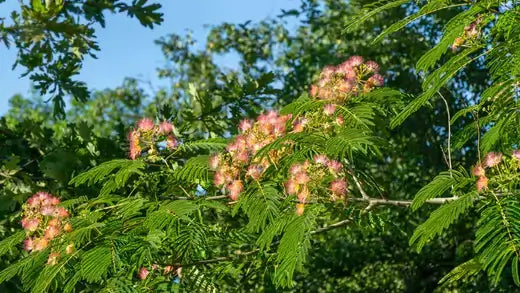Four facts about Mimosa Trees
In the world of flora, few trees can rival the enchanting allure of the Mimosa tree (Albizia julibrissin). Mimosa Trees are revered for their delicate fern-like foliage, vibrant pink puffball flowers, and rapid growth. This tree has captivated the hearts of gardeners, landscapers, and nature enthusiasts alike. Its unique combination of cold weather tolerance, fast growth, and pollinator-friendly characteristics make it a standout choice for various landscapes.
Redbud TreeCold Weather Tolerance:
Defying Expectations One of the most intriguing aspects of the Mimosa tree is its surprising cold weather tolerance. Native to southwestern and eastern Asia, these trees have demonstrated a remarkable ability to withstand temperatures that would typically be considered too harsh for their delicate appearance. While they are often associated with warmer climates, Mimosa trees have expanded their range to more temperate regions, adapting to colder conditions and thriving despite challenging temperatures. This cold weather tolerance is attributed to the tree's ability to enter a state of dormancy during the winter months. As temperatures drop, the Mimosa tree conserves its energy by shedding its leaves, effectively reducing its water loss through transpiration. The tree's bark and vascular tissues are designed to endure colder temperatures without significant damage. This resilience allows Mimosa trees to survive and even flourish in regions that experience frost and snow, defying common expectations of a tree with such delicate-looking blooms.
Fast Growth:
Nature's Accelerated Artistry Mimosa trees are renowned for their remarkable growth rate, earning them a reputation as some of the fastest-growing trees in the botanical world. This rapid growth especially appeals to those seeking to establish a lush canopy or decorative element in their landscapes within a relatively short period. The Mimosa tree's fast growth is a valuable asset for landscape architects and gardeners looking to create an immediate impact. The secret behind the Mimosa tree's accelerated growth lies in its efficient nutrient uptake and utilization. The tree's root system is highly efficient at extracting nutrients and moisture from the soil, supporting its vigorous growth. Moreover, its quick establishment of a robust root system aids in anchoring the tree securely, making it more resilient against adverse weather conditions.
Pollinator Magnets:
A Blossoming Banquet Mimosa trees are not only a delight to the eyes of humans but also a banquet for pollinators. The tree's show-stopping pink blossoms are a magnet for many pollinating insects, including bees, butterflies, and hummingbirds. The flowers, composed of numerous thread-like stamens, offer a plentiful supply of nectar and pollen, making them an irresistible food source for these essential pollinators. The mutualistic relationship between Mimosa trees and pollinators is a testament to the intricate balance of nature. As pollinators collect nectar from the Mimosa's blossoms, they transfer pollen from flower to flower, facilitating the tree's reproduction process. In return, the pollinators receive sustenance and play a vital role in maintaining the ecosystem's biodiversity.
The Ethereal Beauty:
Aesthetic Allure Beyond their remarkable growth rate and ecological contributions, Mimosa trees are celebrated for their inherent beauty. The soft, feathery leaves add a touch of elegance to any landscape, creating a graceful canopy that casts dappled shade below. When the trees bloom, their striking pink flowers make a breathtaking spectacle that adds color and vibrancy to gardens, parks, and streetscapes. The Mimosa tree's visual appeal is not limited to its form. Its presence often enhances the overall aesthetics of its surroundings, serving as a backdrop to other plants and features in the landscape. Whether used as a standalone specimen, a shade provider, or an ornamental accent, the Mimosa tree's beauty transcends seasons and brings a touch of magic to any environment.
The Mimosa tree is a testament to nature's resilience, adaptability, and artistic expression. Its cold weather tolerance defies expectations, fast growth accelerates landscape design, pollinator-friendly flowers contribute to ecosystem vitality, and ethereal beauty enriches every scene it graces. Whether swaying in the gentle breeze of a warm summer day or standing tall against the chill of winter, the Mimosa tree remains a symbol of natural wonder and a testament to the magnificence of the botanical world.




